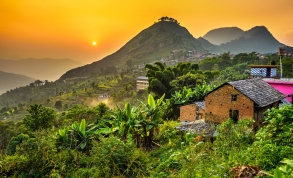Related Content

Water quality
Power generation and improved water quality in India

Food security
Health In Harmony (HIH), in close partnership with the district government and the national park management, worked with local communities to identify reasons for rainforest deforestation in the Gunung Palung National Park Borneo, Indonesia. After community consultation, access to healthcare was identified as a major local need and lack of healthcare access as a potential driver of illegal logging in the National Park. In 2007, Health In Harmony established the Alam Sehat Lestari (ASRI) medical centre. The community-led and designed intervention was a success and a reduction of 70% in deforestation was seen, and healthcare access was provided to over 28,400 patients across all communities in the local area.
In 2020, 4.2 million hectares of tree cover loss, an area the size of the Netherlands, occurred within humid tropical primary forests, which are especially important for carbon storage and biodiversity. The emissions from this forest loss (2.64 gigatons CO2) are equivalent to the annual emissions of 570 million cars. Protected areas can reduce deforestation in tropical forests with benefits for conservation and climate mitigation, but often exclude and disenfranchise local communities who live near protected areas. Ignoring the needs of local people can, in turn, lead to unsustainable forest use, as communities with few alternatives illegally log trees and convert land in order to survive (Jones et al., 2020).
Health In Harmony, through extensive consultation with local communities, identified healthcare access costs as a key driver of illegal logging and unsustainable forest use. This includes not only the cost of care, but also transportation to healthcare services, food and housing costs while away from home, and income loss while sick. The need to pay for these costs can lead families to overexploit the environment, making deals with outsiders to do so, or their absence from the land can leave them unable to defend it from outsiders. HIH established a local health clinic that provided accessible healthcare services by allowing for non-cash payment and discounts on care based on the amount of logging in a given community. Additionally, conservation programmes, educational programmes, and alternative livelihood training was offered.
The intervention led to a 90% reduction in the number of households relying on logging as a primary income source, equating to the prevention of 27.4 km2 of deforestation in the national park between 2008 and 2018. There was a 70% reduction in annual forest loss compared to the equivalent period between 2001 and 2007. This reduction in forest loss was estimated to have prevented 0.59 billion kg of above ground carbon loss (90% CI, 0.27–1.13 billion kg). The effect of this intervention on prevented CO2 loss may be underestimated as the project has also promoted the regeneration of secondary forest, and the impacts of preventing below ground carbon loss have not yet been quantified (Jones et al., 2020).
The health clinic was accessible to both the communities who did and did not participate in the intervention as it was unethical to deny access to healthcare based on participation. The intervention provided healthcare access to more than 28,400 patients across all communities, although clinic usage and patient visitation frequency were highest in communities participating in the intervention. From 2007 to 2012, infant mortality declined from 3.4 to 1.1 deaths per 100 households. This was reflected in significant declines over time in diagnosed cases of malaria, tuberculosis, childhood-cluster diseases, neglected tropical diseases (NTDs), chronic obstructive pulmonary disease (COPD), and diabetes in all communities. Lower and upper respiratory infections and cases of dental diseases increased across all communities over the study period but increased significantly less in intervention communities (Jones et al., 2020; Webb et al., 2018).
A large factor in the success of this intervention was that it was community-led and designed, and addressed different areas and provided multiple solutions at the same time. The problems identified in the community were intersectional (i.e. they required access to healthcare but also education programmes and training on sustainable livelihoods). The solutions provided to meet these needs were also intersectional. Factors that constituted "high engagement" with the intervention led to larger effects. There was evidence of a dose–response relationship between forest loss and intervention engagement across 36 of the 73 villages. Those that were highly engaged with the intervention, i.e. total individual contact across all intervention activities (clinic visits, attending meetings, education activities, livelihoods training), showed a significant decrease in forest loss, while medium engagement showed no change and least engaged villages showed an increase. Therefore, achieving higher engagement may achieve larger results.
Lack of access to healthcare has been shown as the main driver of ecosystem degradation in other parts of Indonesia (Bukit Baka Bukit Raya National Park), Madagascar, the Philippines, and Brazil. Conversations with other organisations that have used the same or similar techniques (i.e. radical listening to understand community priorities) in other parts of Indonesia, Malaysia, Mozambique, and Rwanda have also found healthcare access to be one of the main drivers. Therefore, scale up of this intervention would require providing affordable access to healthcare, as well extensive engagement with the local community to identify the main drivers of illegal logging and the services needed to avert such practices. For recommendations on replicated implementation to be possible an in-depth evaluation would be needed to identify the components of the intervention that are most effective and how these components were implemented.
HIH co-founder, Dr. Kinari Webb, said: "While we have very good data that what we do works, we do not know exactly why or if some parts of our work are more important than others. At this time, we don’t have data on whether it is the provision of care at affordable prices (including for no money at all), the discounts, our intersectional approach, or the process of radical listening itself which is so transformative, but we do know that it is possible to move towards mutual thriving for ecosystems and humans at the same time."